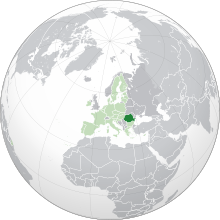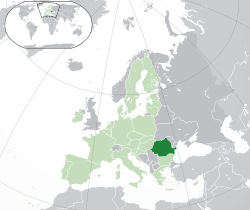
Back Румыниа Abkhazian Rumania ACE Румание ADY Roemenië Afrikaans Rumänien ALS ሮማንያ Amharic Romania AMI Rumanía AN Rumǣnia ANG Romania ANN
Romania România (Romanian) | |
|---|---|
| Anthem: "Deșteaptă-te, române!" ("Awaken thee, Romanian!") | |
Location of Romania (dark green) – in Europe (green & dark grey) | |
| Capital and largest city | Bucharest 44°25′N 26°06′E / 44.417°N 26.100°E |
| Official language | Romanian[a] |
| Ethnic groups |
|
| Religion |
|
| Demonym(s) | Romanian |
| Government | Unitary semi-presidential republic |
| Klaus Iohannis | |
| Marcel Ciolacu | |
| Nicolae Ciucă | |
| Daniel Suciu | |
| Legislature | Parliament |
| Senate | |
| Chamber of Deputies | |
| Formation | |
| 1330 | |
| 1346 | |
| 24 January 1859 | |
• Independence from the Ottoman Empire | 13 July 1878 |
| 25 March 1881 | |
| 1 December 1918 | |
| 30 December 1947 | |
| 8 December 1991 | |
| Area | |
• Total | 238,397 km2 (92,046 sq mi)[5] (81st) |
• Water (%) | 3 |
| Population | |
• January 2024 estimate | 19,064,409[6] (65rd) |
• 2021 census | |
• Density | 79.9/km2 (206.9/sq mi) (136th) |
| GDP (PPP) | 2024 estimate |
• Total | |
• Per capita | |
| GDP (nominal) | 2024 estimate |
• Total | |
• Per capita | |
| Gini (2023) | medium inequality |
| HDI (2022) | very high (53rd) |
| Currency | Romanian leu (RON) |
| Time zone | UTC+2 (EET) |
• Summer (DST) | UTC+3 (EEST) |
| Calling code | +40 |
| Internet TLD | .ro |
Romania[b] is a country located at the crossroads of Central, Eastern, and Southeast Europe. It borders Ukraine to the north and east, Hungary to the west, Serbia to the southwest, Bulgaria to the south, Moldova to the east, and the Black Sea to the southeast. It has a mainly continental climate, and an area of 238,397 km2 (92,046 sq mi) with a population of 19 million people (2023). Romania is the twelfth-largest country in Europe and the sixth-most populous member state of the European Union. Europe's second-longest river, the Danube, empties into the Danube Delta in the southeast of the country. The Carpathian Mountains cross Romania from the north to the southwest and include Moldoveanu Peak, at an altitude of 2,544 m (8,346 ft). Romania's capital and largest city is Bucharest. Other major urban centers include Cluj-Napoca, Timișoara, Iași, Constanța and Brașov.
Settlement in the territory of modern Romania began in the Lower Paleolithic, later becoming the kingdom of Dacia before Roman conquest and Romanisation. The modern Romanian state emerged in 1859 through the union of Moldavia and Wallachia and gained independence from the Ottoman Empire in 1877. During World War I, Romania joined the Allies, and after the war, territories including Transylvania and Bukovina were integrated into Romania. In World War II, Romania initially aligned with the Axis but switched to the Allies in 1944. After the war, Romania became a socialist republic and a member of the Warsaw Pact, transitioning to democracy and a market economy after the 1989 Revolution.
Romania is a developing country with a high-income economy, recognized as a middle power in international affairs.[11] It hosts several UNESCO World Heritage Sites and is a growing tourist attraction, receiving 13 million foreign visitors in 2023.[12] Its economy ranks among the fastest growing in the European Union,[13][14] primarily driven by the service sector. Romania is a net exporter of cars and electric energy worldwide, and its citizens benefit from some of the fastest internet speeds globally. Romania is a member of several international organizations, including the European Union, NATO, and the BSEC.
- ^ "CONSTITUTIE (R) 21/11/1991 - Portal Legislativ">". legislatie.just.ro. Retrieved 12 November 2024.
- ^ "Populaţia rezidentă după etnie (Recensământ 2021)". www.insse.ro (in Romanian). INSSE. Archived from the original on 2 July 2023. Retrieved 21 September 2023.
- ^ "Populaţia rezidentă după religie (Recensământ 2021)". www.insse.ro (in Romanian). INSSE. Archived from the original on 4 August 2023. Retrieved 21 September 2023.
- ^ Kivu, Mircea (19 August 2022). "Un recensământ cu grave probleme". Contributors. Retrieved 13 January 2023.
- ^ "Romanian Statistical Yearbook (2023) – 1.8 Administrative organisation of Romanian territory, on December 31, 2022 (pg.17)" (PDF). www.insse.ro. National Institute of Statistics (Romania) - INSSE. 19 February 2024.
- ^ "On 1st January 2024, the usually resident population amounted to 19064409 persons, a growth of 9.9 thousand persons compared to 1st January 2023" (PDF). www.insse.ro. National Institute of Statistics (Romania) - INSSE. 30 August 2024. Retrieved 30 August 2024.
- ^ "Populația după etnie la recensămintele din perioada 1930-2021". www.insse.ro (in Romanian). National Institute of Statistics (Romania) - INSSE. Archived from the original on 28 September 2023. Retrieved 4 March 2024.
- ^ a b c d "World Economic Outlook Database, October 2024 Edition. (Romania)". www.imf.org. International Monetary Fund. 22 October 2024. Retrieved 22 October 2024.
- ^ "Gini coefficient of equivalised disposable income – EU-SILC survey". ec.europa.eu. Eurostat. Archived from the original on 9 October 2020. Retrieved 13 April 2024.
- ^ "Human Development Report 2023/2024" (PDF). United Nations Development Programme. 13 March 2024. Archived (PDF) from the original on 13 March 2024. Retrieved 13 March 2024.
- ^ Radu Magdin (February 2021). "Middle Powers Realities in the EU amid Great Power Ambitions" (PDF). ier.gov.ro. European Institute of Romania. Archived (PDF) from the original on 13 March 2024. Retrieved 19 March 2024.
- ^ "Travel and tourism in Romania - statistics & facts". statista.com. Retrieved 1 October 2024.
- ^ Băzăvan, Adrian (20 August 2023). "România are, de departe, cea mai mare creștere economică din Europa". Cred în România (in Romanian). Archived from the original on 18 June 2024. Retrieved 29 January 2024.
- ^ "România, premiantă în UE la creștere economică. Dar Galați și Dâmbovița au crescut cu 0,1%, în timp ce Cluj și Timiș cu 4%. Cum stau alte județe- HARTA - HotNews.ro" (in Romanian). 14 August 2024. Retrieved 2 September 2024.
Cite error: There are <ref group=lower-alpha> tags or {{efn}} templates on this page, but the references will not show without a {{reflist|group=lower-alpha}} template or {{notelist}} template (see the help page).



